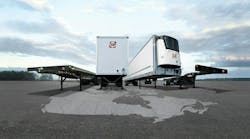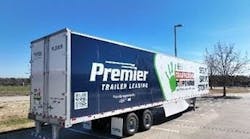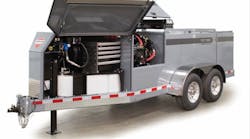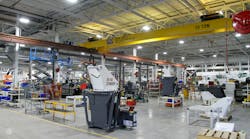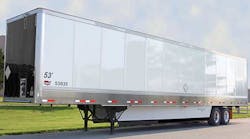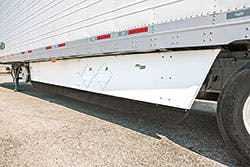IMAGINE getting an order for some trailers, just like the trailers that you delivered to the customer earlier in the year. But this time you will not be able to sell them. Federal regulations will not allow it.
This scenario could be reality five years from now as the EPA and NHTSA jointly contemplate ways to include truck trailers in future regulations designed to reduce greenhouse gas emissions generated by commercial vehicles.
Representatives of the Environmental Protection Agency spent a major portion of 2014 research gathering information for what potentially could be a major new regulation for trailer manufacturers and their customers—an effort to reduce greenhouse gas and fuel consumption by reducing the amount of effort required to pull trailers. The regulation of trailers is expected to be included in Phase 2 of regulations aimed at the commercial vehicle industry. Other segments of the program include heavy-duty tractors, engines, vocational vehicles, and heavy-duty pickups and vans, all of which were part of Phase 1.
It’s now the trailer industry’s turn.
In reality, the number of ways that trailers affect fuel consumption is rather limited. The main ways include aerodynamic drag and rolling resistance. As such, regulators are considering low rolling resistant tires, automatic tire inflation systems, as well as ways to reduce trailer weight and aerodynamic drag.
In advance of this rulemaking, officials from EPA as well as NHTSA have been with the Truck Trailer Manufacturers Association and other stakeholders to learn more about the industry that they are planning to regulate.
Details of the regulation are not expected to be made public until a notice is published in The Federal Register in March. But a presentation given to the Truck Trailer Manufacturers Association in October provided a glimpse into what the agencies are considering.
“We have had over 30 meetings with stakeholders in the last 10 months,” regulators told TTMA during the conference. “Many included visits to their facilities.”
EPA officials have toured several TTMA trailer manufacturing members and one associate member.
The joint EPA and NHTSA rulemaking would apply only to new trailers. It would directly regulate trailers at the OEM level. It would be up to each manufacturer to figure out how to meet the goals of the GHG program while simultaneously satisfying the requirements of the customer.
What they are thinking
Regulators told TTMA that they are looking primarily to van trailers, but they also are considering ways to address other trailers, primarily through use of tire technologies.
“We are considering several stringency options that would phase in over the duration of the program,” they told TTMA. “Current adoption rates and effectiveness of these technologies suggest that we could initiate the trailer program on a modest scale as early as 2018 and potentially increase stringency in the 2020 to 2025 timeframe.”
EPA will draw its authority to regulate trailers under the Clean Air Act, while NHTSA’s authority comes from the Energy Independence and Security Act (EISA), the agency says.
Under the Clean Air Act, manufacturers obtain a certificate annually, prior to sale, certifying that their product complies with applicable standards. Trailer manufacturers can expect that a similar process will be applied to them.
“We consider trailers to be part of the combination tractor-trailer vehicle,” regulators said.
Trailer manufacturers will be responsible for compliance. They would apply for certificates annually. Other requirements of Phase 1 that can be expected to be extended to Phase 2 participants include:
• Pre-certification prep. This involves identifying the technologies that will be offered to customers.
• Applying for certification. Included in this step is to group the manufacturer’s product line into “families”—groups of trailers exhibiting comparable performance data. Manufacturers would then estimate the amount of CO2 and fuel consumption associated with each family. Estimates are based on the use of the Greenhouse Gas Emissions Model (GEM CO2) tool available from EPA. An explanation on the use of the tool is available at http://www.epa.gov/otaq/climate/documents/420b11019.pdf.
• End-of-year compliance data. The manufacturer is to report actual sales for the year and determine compliance by entering those sales numbers into GEM calculator to determine final compliance.
Banking on credits
A system of buying and selling emissions credits, similar to that associated with the automobile industry, is one of a variety of measures that the agency is considering putting into rulemaking that is expected to be announced in March.
Under such a system, certain types of trailers would be considered fuel efficient. Others would be unable to meet limits specified in the upcoming regulations. Trailer manufacturers would be allowed to “bank” credits for the fuel efficient trailers and use those credits to offset the extra greenhouse gas emissions that tractors are expected to generate when they pull noncompliant trailers.
A trailer manufacturer would be allowed to build noncompliant trailers two ways:
1. If the manufacturer can sell enough fuel efficient trailers to offset the noncompliant models.
2. If the OEM can get a competing trailer manufacturer to sell surplus credits.
If not, production of those noncompliant trailers will have to wait until next year.
The “corporate average fuel economy” system for trailer manufacturers is but one of many concepts that EPA is considering. For the past several months, the Truck Trailer Manufacturers Association has been working with EPA to provide the agency with information about how the trailer manufacturing industry functions and how proposals that are being considered could impact not only the trucking industry specifically but also the areas of the economy in general that rely on trucking.
Recently Trailer/Body Builders had a conversation with Jeff Sims, president of TTMA and Dick Giromini, TTMA chairman of the board for 2014-2015. Here is what they had to say:
TBB: As you know the EPA has been considering pulling trailers in the GHG2 bill, expected to come in March 2015, what are your thoughts on mandating trailers into a GHG2 rule?
Giromini: As a baseline, TTMA would prefer that trailers not be included in regulations such as this, but we have been told they will be. Therefore, we are working with EPA to help them better understand the trailer industry so that they can create regulations that help reduce greenhouse gas emissions and yet minimize any negative impact such a rule would have on the industry.
Sims: Initially the EPA planned to include all types of trailers in the regulation. We have been working with EPA to help them recognize how complex our industry is and how varied the products are that we manufacture. For example, for aerodynamic devices to even have an effect, trailers have to travel fast enough for aerodynamic drag to make a difference in fuel consumption. Some trailers never reach that speed. Other trailers have work-performing equipment on them that would interfere with aerodynamic devices. EPA needs to look closely at the wide varieties of trailers in order to develop something that makes sense.
Giromini: The TTMA understands that trailer-related regulatory strategies are being looked at in response to the President’s directive to expand on gains of fuel economy/ greenhouse gas emissions for heavy duty vehicles. The TTMA believes consideration should be given to expanding voluntary programs, such as with the EPA SmartWay program. Even without a mandatory program, many fleets are already testing various fuel savings technologies in real world conditions, to see what the benefits are in their own specific application, as trailer use, type, and duty cycle are wide and varied. When you look at history, trailer manufacturers have been proactive in addressing uptime, performance, and safety. We have done so on a voluntary basis because it’s our job to support the customers we serve by optimizing trailer performance. Regulations have a cost for fleets.
TBB: How has TTMA been involved with the EPA in the early rulemaking process?
Sims: In the past year, the TTMA and the EPA have started a dialog on GHG2. The TTMA’s goal is to help the EPA understand that most trailers are typically designed for a specific freight application; that current technology adoption rates are driven by market forces; and that not all trailer types will benefit from adopting fuel efficiency technologies. We have had phone and face-to-face conversations. They have met with us at TTMA offices, and they attended our summer engineering meeting this past year. They also have toured the manufacturing plants of several of our members and also have visited the facilities of one of our associate members. EPA officials are listening and are considering the feedback that TTMA companies have provided. And it has been during these meetings that we have learned the most about what they have been considering for this regulation.
Giromini: This has grown into a very interactive process as EPA has begun to recognize the complexity of our industry. They are more accepting today of the input we have provided.
TBB: Based on the discussions you have had so far, what does the EPA appear to be proposing?
Giromini: It appears that the EPA will target 53’ dry and refrigerated vans first. In later years, they may look at other trailer types. It is expected that the rule will start with model year 2018 trailers.
It comes down to the 80-20 rule. EPA is looking at the biggest immediate impact, and they know that the 53-ft van trailer is the workhorse of the industry. That’s where the numbers are, and that’s where the potential for effect will be. Van trailers make up between 60% and 70% of the industry, and they are the ones that are most often traveling long distances at highway speeds, making them the best application for aerodynamic devices.
TBB: What has been the industry response to the preliminary EPA proposals?
Giromini: The general response has been that we need to look at a more comprehensive set of solutions than just trying to mandate that fuel savings technologies be installed on trailers. Current restrictions on trailer length and weight are just some examples of other regulatory changes that should be considered if we are serious about maximizing the efficiency of freight hauling in North America.
One thing that would be an immediate benefit would be to authorize 33-ft-long pup trailers. That would provide LTL carriers with an 18% increase in load capacity without impacting load limits. It also would reduce fuel consumption and greenhouse gas emissions. Fewer trucks would be needed, which would help reduce congestion. Plus, there would be no transition issues—trailer manufacturers could readily provide the equipment. LTL carriers such as FedEx and UPS are promoting this idea, but it’s such an appealing improvement in efficiency that we believe truckload carriers would consider it, too.
We also could reduce fuel consumption and greenhouse gas emissions by allowing single trailers to carry more. The majority of 53-ft trailers cube out before they ever reach maximum GVWR. As low as 10% of fleets weigh out first.
TBB: What kinds of trailers might be excluded?
Giromini: That’s an excellent question. The TTMA has emphasized with the EPA that tank trailers, flatbed trailers, and other specialty trailer types will not necessarily see benefits from the addition of aerodynamic devices. These highly specialized trailers have different use patterns than van trailer fleets. Many of these specialized trailers haul locally or regionally, infrequently reach highway speeds, have unique freight hauling requirements, and may even operate off-road for a portion of time.
TBB: What kind of performance standard will the regulation set in order to improve fuel economy or reduce greenhouse gases?
Sims: That is yet to be determined. We expect that EPA will establish a baseline and then require trailer manufacturers to improve trailer performance in this area by a certain amount. They have said that manufacturers will not receive credit for past performance, which we interpret to mean that if you currently are producing SmartWay trailers, you will be expected to improve upon that.
TBB: How will performance be measured?
Sims: Several methods are being considered.
• Wind-tunnel testing is one way, although EPA recognizes that that approach may be a burden.
• “Coastdown” is being used by tractor manufacturers. With this method, the vehicle is driven at 60 mph. At a defined point, the vehicle is then allowed to coast. The distance the vehicle coasts before coming to a complete stop is then measured and compared against a control vehicle.
• Fluid dynamics software.
Regulators are also considering an alternative testing option that would allow aero device manufacturers (or others) to test aero devices on a representative trailer and provide results to EPA for pre-approval. Trailer manufacturers could choose appropriate pre-approved technologies to meet the standard and avoid performing the tests themselves
TBB: How will the averaging of drag reduction coefficient numbers affect trailer manufactures—especially those that do not manufacture large numbers?
Giromini: Averaging drag reduction coefficients is a more difficult task that most realize. Think about all the variations a trailer can have that affect drag—everything from tire carriers to lift gates to multi-axles to drop-decks. In addition, trailer design does not necessarily allow for specific aerodynamic devices to be utilized – for example, current boat tail designs do not work with overhead doors. A better solution would be to expand the EPA SmartWay program and focus on potentially increasing the number of van and refrigerated trailers that have fuel saving devices installed every year.
TBB: What are your thoughts on the concept of banking fuel efficiency credits?
Giromini: This cannot work in the trailer industry. The difference between us and the auto industry is sheer volume. They have the ability to test and then spread the cost of those tests over a tremendous number of vehicles. Cars have limited pre-engineered options. We build to a specific application that is different from order to order. If the auto industry has sold too many lower-than-average-fuel-economy cars, manufacturers can mix different types of vehicles and push them to their dealers. We don’t build a stock design—we build to the individual customer. And if our mix of trailers is bad, we can’t just promote more fuel efficient trailers. We would have to shut down production.
Sims: EPA and NHTSA are used to dealing with the automotive industry, but that does not compare with the trailer industry. It would take trailer manufacturers 64 years to produce what the car industry builds in a year. The CAFÉ system that has been used there can’t be applied here. We frequently build quantities of one. We can’t afford to test that trailer, and we can’t pass the cost on to the customer. And we can’t control what customers order.
Giromini: We will not be able to trade credits with competitors. Everyone in the industry would hold onto credits for a rainy day because no one knows the mix of trailers they will be building from one year to the next.
TBB: Since aerodynamic devices are not suited to many types of trailers, has EPA proposed any other ways for trailers to contribute to reductions in greenhouse gases or improvements in fuel economy?
Giromini: Low-rolling-resistance tires, better inflation pressures, and lower running speeds—60-62 mph—are being considered. Lighter weight trailers are also a possibility, but we have been doing that for years. Emission regulations that engine manufacturers have had to meet have made trucks heavier by quite a margin. Our customers have been looking to us to save weight on the trailer side so that they are not penalized by the additional weight of the tractors that they have had to buy.
TBB: Will there be exceptions for fleets that run too slowly to benefit from improved aerodynamics?
Giromini: As mentioned previously, we hope the EPA will take into consideration that not all trailer types will benefit from utilizing fuel savings technologies. Not only will some trailer types never recapture the cost of these technologies in actual fuel savings, but, even with fuel savings technologies employed, the way these trailers are utilized do not allow them to attain the EPA’s stated goal of improving fuel economy and reducing greenhouse gas emissions through use of drag reduction technologies.
TBB: Will this proposal require trailer builders to sell GHG devices to fleets whether they’re effective or not?
Giromini: That remains to be seen. We hope we have been able to provide enough information and data to the EPA to allow them to focus only on those trailer types where employing fuel savings technologies will be effective.
TBB: What about federal excise tax and weight limits? Will fleets be required to pay tax on a mandatory component? And will the weight of aerodynamic devices reduce the amount of cargo a trailer may transport?
Giromini: We strongly believe that if these devices are required, they should be exempt from both FET and weight limits. If the EPA is mandating that these devices be installed, fleets should not be penalized from a tax and weight standpoint. We are hopeful that, as has been done in the past, Congress and other government agencies will enact specific exemptions for these devices simultaneously with the adoption of any regulation in this area by the EPA.
How will this work with SmartWay and CARB’s requirements?
Giromini: We have emphasized in our dialog with the EPA that the EPA SmartWay program is already widely used in the industry. Expansion of the SmartWay program should be considered, rather than trying to implement a new compliance program. In addition, we would like to see alignment between the US EPA and CARB to reduce confusion and to lessen complexity in the adoption of any new rules by fleets that operate throughout the Western United States.
TBB: A fleet that runs at low speeds and routinely weighs out will have to run more trips and emit more GHGs. Who’s going to pay for the extra diesel burned, for the extra drivers, and for the extra insurance to cover those extra trips?
Giromini: As mentioned previously, we hope the EPA will take into consideration that not all trailer types will experience the cost-benefit from utilizing fuel savings technologies – and that the goal of improving fuel economy and reducing greenhouse gas emissions may not be obtainable by mandating reductions in drag in certain types of trailers.
TBB: Any final comments?
Giromini: We haven’t moved the needle as much as we would have liked so far, but we will continue with a diligent effort to dialog with EPA regarding the challenges in their proposal.
Sims: Our industry is self-regulating. We encourage our regulators to look at what is happening with the SmartWay program. People see the benefit of SmartWay. Fleets and manufacturers have responded to this voluntary program on their own accord. LTL fleets almost universally have adopted side skirts. They have done so freely because they have gotten a benefit and they improve the environment in the process.
For their part, regulators told TTMA that they continue to encourage input, including:
• Distinct characteristics of trailers not amenable to aero or tire technologies
• Appropriate definition of “model year” for trailers
• The durability of low rolling-resistance tires.
• The relationship between trailer length/type and typical trip distance.
• Appropriate incentives for consideration.
• Any data and calculations related to trade-offs between the weight of aerodynamic devices and additional trips needed. ♦
______________
Special meeting scheduled to discuss proposed trailer regulation
A special engineering meeting will be held April 29 at the beginning of this year’s annual TTMA convention.
Officials from the Environmental Protection Agency and the National Highway Traffic Safety Administration will have been invited to participate.
The meeting will be held the month after EPA and NHTSA are scheduled to publish details of the proposed regulation on greenhouse gases and fuel economy associated with truck trailers. ♦
